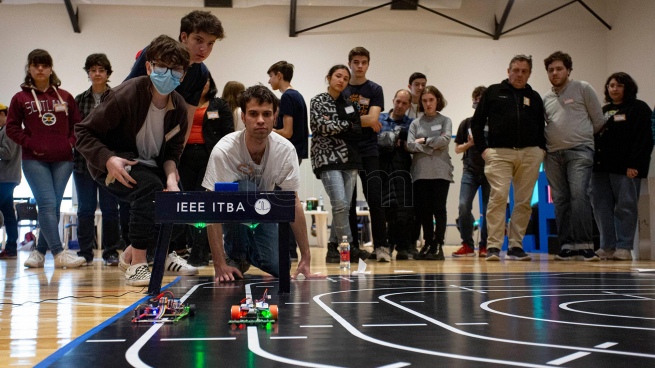A total of 34 robots created by secondary, university and amateur students participated in the first edition of the Asimov Cup, an open robotics competition organized by the Technological Institute of Buenos Aires (ITBA) and held at its headquarters in the Buenos Aires neighborhood of Parque Patricians.
Promoted by the student group Institute of Electrical and Electronics Engineers (IEEE), one of the largest engineering organizations in the world, the tournament received more than 60 competitors aged 16 and over, in what they considered an “exciting” day.
“It is a very enriching experience for those who compete. We are very happy to have been able to bring this beautiful activity to our university,” Agustín Gullino (21), an electronic engineering student at ITBA and one of the organizers of the event, told Télam, which he announced will be repeated again next year.

“These contests are a great challenge that pushes a lot to improve, because throughout the competitions one tends to find different strategies that work and discard those that do not, find strengths and weaknesses, among other things”, explained.
Throughout the day, students of all ages, families and fans or as they prefer to call themselves “hobbists” competed with a total of 34 robots in the categories of sumo, minisumo and racing.
In the first two categoriesthe competitors must position their robots in a semicircular tatami or ring, similar to those of judo or karate, and program the strategy that the robot must develop autonomously during the contest.

The judge gives the order and the competitors move away, expectantly and with obvious nervousness, to start the fight, which consists of three three-minute rounds interspersed with a minute of rest, to quickly adjust details of the robot.
Whoever gets a Yuhkoh or point wins the roundwhich is awarded when the opposing robot touches the ground outside the ring or when there is no movement in the motor part of the robot for 30 seconds.
Ramiro Páez (20) is a young programming student who has participated in robot competitions since he was 7 years old together with his father Fito (51), an electronic engineer and robotics teacher at a secondary and tertiary school in the Buenos Aires town of San Nicolás. .
“You really learn a lot in these competitions, you are constantly studying, adjusting and programming every detail, depending on each competition,” said father and son, after qualifying as finalists in the sumo and minisumo categories.
“You have to be very strategic in these categories,” said Fito and recognized Ramiro as “the most strategic of the two.”

“We always have to measure and analyze the capabilities of our robot and those of the opponent to define whether the strategy will be more of an attack or a defense,” explained the young man, who entered the competition with three robots, two of them built “from zero” by themselves.
As established by the tournament regulations, adapted from the Argentine National Robotics League, in the sumo category the participating robots have a maximum weight of 3,000 grams and 20 centimeters on each side, with no maximum height; while at a minimum the robots are 500 grams and 10 centimeters on each side.
“It is a very important learning process, in which in addition to the base of elements to build a robot, creativity and ingenuity are needed to be able to give it the best characteristics”Paul Cossutta
Pablo Cossutta, professor and researcher at the Center for Research and Development of Industrial Electronics (Cidei), highlighted to this agency “the sense of integration and cooperation that is generated between people from different fields and even different locations in Buenos Aires when they come to compete here “.
And, he added: “I celebrate these instances as a teacher and researcher at the institute (Cidei) and also as the student I once was, who constantly competed in these events.”
The teacher, who officiated as a jury during the contest, assured that these spaces foster “a very important competitive and cooperative spirit” and pose “a technological challenge” by having to “develop with scarce resources and time something that is more advantageous than the rest”.
“It is a very important learning process, in which, in addition to the base of elements to build a robot, creativity and ingenuity are needed to be able to give it the best characteristics,” he said.
Santiago (16) and Florencia (17), two fourth-year students from Ort High School, showed up with three other classmates to compete in the racing category with their speedy robot nicknamed “Dashito”.

In this modality, completely autonomous robots 20 centimeters long and 14 wide, with a height limit of 10 centimeters, go through a pre-established circuit on a plastic canvas and whoever manages to do it in the shortest time is the one who wins.
“What I like the most is being able to put something together myself, build it from scratch and have it work, it’s very incredible. Understand the mechanisms so that each piece can do something in an assembled way”expressed Florencia, who assured that she wanted to dedicate herself to this when she finished school.
“The assembly process was difficult, at first it was a bit difficult, but we had two weeks of vacation (from school) to perfect it for today,” said both young people, who play the role of physicists in the group, that is, those who assemble and they design, while their peers are programmers.
“This was the first time we presented ourselves and our first robot, which took us three months”, the students said and concluded: “It went well and we are very happy, now we will adjust details for our next competition”.


















